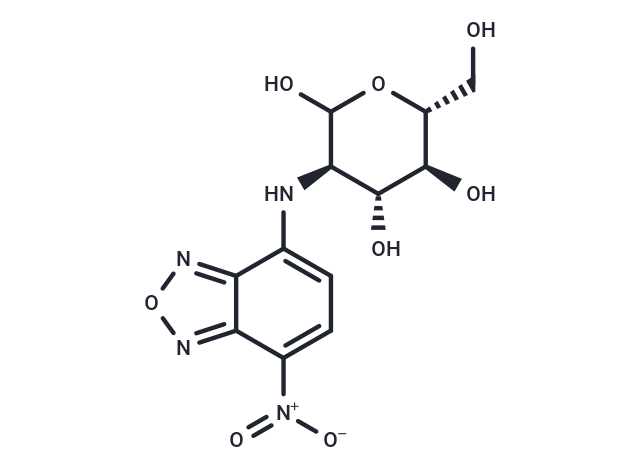Shopping Cart
Remove All Your shopping cart is currently empty
Your shopping cart is currently empty
2-NBDG is a fluorescent indicator for direct glucose uptake measurement. It is an indicator of cell viability.

| Pack Size | Price | USA Warehouse | Global Warehouse | Quantity |
|---|---|---|---|---|
| 1 mg | $35 | In Stock | In Stock | |
| 5 mg | $92 | In Stock | In Stock | |
| 10 mg | $139 | In Stock | In Stock | |
| 25 mg | $278 | In Stock | In Stock | |
| 50 mg | $438 | In Stock | In Stock | |
| 100 mg | $662 | In Stock | In Stock | |
| 200 mg | $926 | In Stock | In Stock | |
| 1 mL x 10 mM (in DMSO) | $93 | In Stock | In Stock |
| Description | 2-NBDG is a fluorescent indicator for direct glucose uptake measurement. It is an indicator of cell viability. |
| In vitro | METHODS: Flow cytometry was used to detect glucose uptake: 1, Cells were seeded at 1*104/well in 96-well plates, and the experiment was performed within 24-48 h. The cells were incubated at 37 ℃ for 10-180 min. 2, Remove the cell culture medium, add fresh medium containing 2-NBDG (5-40 µM), and incubate for 10-180 min at 37 ℃. 3. Remove the medium and wash twice with pre-cooled PBS to stop the 2-NBDG uptake reaction. Resuspend in fresh medium and perform flow cytometry within 30 min. [1] |
| In vivo | METHODS: Glucose uptake by circulating breast cancer cells was detected by fluorescent microscopy: 1. A mouse blood sample (100 µL/mouse) was collected by puncturing the mouse saphenous vein. 2. Incubate the blood sample containing circulating breast cancer cells with 2-NBDG (5 µg/100 µL blood) for 30 min at 37℃ in a dark incubator. 3. Add the magnetic bead suspension (1µL 1%) to 100 µL of blood sample and incubate for 30 min at 4°C with gentle shaking to promote binding of the magnetic beads to the circulating breast cancer cells. 4. Separate the circulating breast cancer cells from the blood using a magnetic separation rack, wash with PBS 3 times, resuspend in 100 µL PBS and transfer to a 96-well cell plate. 5. 2-NBDG uptake by circulating breast cancer cells was examined under a fluorescence microscope equipped with a 488 nm filter. Large cells with a fluorescent signal derived from fluorescent 2-NBDG uptake by cells were counted as hypermetabolic circulating breast cancer cells, and small-sized normal mouse blood cells (lymphocytes and RBCs) showed no or little 2-NBDG fluorescent signal. [2] |
| Cell Research | Flow cytometry to detect glucose uptake Operation steps: a. Cells were seeded in 96-well plates at 1*104/well and the experiment was performed within 24-48 h; b. Cell culture medium was removed, fresh culture medium containing 2-NBDG (5-40 µM) was added, and incubated at 37 ℃ for 10-180 min; c. Culture medium was removed, and the cells were washed twice with pre-cooled PBS to stop the 2-NBDG uptake reaction. Resuspended in fresh culture medium, flow cytometry was performed within 30 min. |
| Molecular Weight | 342.26 |
| Formula | C12H14N4O8 |
| Cas No. | 186689-07-6 |
| Smiles | OC[C@H]1OC(O)[C@H](Nc2ccc([N+]([O-])=O)c3nonc23)[C@@H](O)[C@@H]1O |
| Relative Density. | 1.750 g/cm3 (Predicted) |
| Color | Orange |
| Appearance | Solid |
| Storage | store at low temperature | Powder: -20°C for 3 years | In solvent: -80°C for 1 year | Shipping with blue ice/Shipping at ambient temperature. | ||||||||||||||||||||||||||||||||||||||||
| Solubility Information | H2O: 5 mg/mL (14.61 mM), Sonication and heating to 60℃ are recommended. DMSO: 52.5 mg/mL (153.39 mM) | ||||||||||||||||||||||||||||||||||||||||
Solution Preparation Table | |||||||||||||||||||||||||||||||||||||||||
H2O/DMSO
DMSO
| |||||||||||||||||||||||||||||||||||||||||
| Size | Quantity | Unit Price | Amount | Operation |
|---|

Copyright © 2015-2025 TargetMol Chemicals Inc. All Rights Reserved.